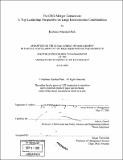The CEO-merger connection : a top leadership perspective on large intercorporate combinations
Author(s)
Park, Kathleen Marshall
DownloadFull printable version (28.58Mb)
Alternative title
Chief executive officer-merger connection : a top leadership perspective on large intercorporate combinations
Other Contributors
Sloan School of Management.
Advisor
John S. Carroll.
Terms of use
Metadata
Show full item recordAbstract
To better understand large mergers and acquisitions (M&A) as major intercorporate strategic maneuvers, I study a key concern from the chief executive perspective at each stage of combining two firms. For the inception stage, I explore CEO merger motives; for the implementation stage, I examine CEO leadership; for the outcome stage, I consider the postacquisition mobility consequences for CEOs as well as the financial performance of the merged firms. ][ study these issues in the total sequence of merging from the perspectives of the acquiring and the target CEOs. The investigation relies on interviews with selected CEOs and also secondary data on all CEOs and firms participating in the 158 largest U.S. public M&A deals announced during the 1990s worldwide merger wave and completed during 1993-2002. These large deals embodied unprecedented valuation and complexity requiring the sustained attention and commitment of chief executives from both sides of the transaction. The first empirical section explores CEO motivations for merging. Merger motives have not been well understood, and previous research has tended to segment perspectives from different disciplines. (cont.) Drawing on strategic management, organization studies, and financial economics, I examine the five merger motives advanced to date-synergy, managerialism, hubris, free cash flow, and imitation-and add the overarching motive of metamorphosis. The metamorphosis motive proposes that mergers create profound organizational change in three dimensions: (1) management structure, (2) strategic direction, and (3) corporate culture. The second section examines CEO leadership roles in M&A transactions. Drawing on the knowledge and resource based views of the firm and the literature on the chief executive function, I identify three phases in the similar merger-related roles of acquiring and target CEOs. In the context of large U.S. mergers in the financial services, computer software, oil and gas, telecommunications, and utilities industries, the purview of acquiring and target CEOs included: (1) making the merger, (2) placing and displacing people, and (3) fulfilling the strategic vision. The third section applies perspectives from human capital, social capital, market discipline, and dyadic relative standing to analyze the impact of mergers and acquisitions on the subsequent career mobility of the merger architects. (cont.) My analysis differs from previous research by providing a finer-grained operationalization of relative status, examining the fates of both acquiring and target CEOs, and determining postacquisition career outcomes beyond stay or go. Based on a sample of completed large M&A transactions, I conclude that acquiring as well as target CEOs experience elevated departure rates compared to non-merged CEOs; that human capital, social capital and market discipline do not explain departure incidence but that the status parity or discrepancy between the partnering CEOs does; and that merger-displaced CEOs continue to have elite job prospects in public and private firms. Moreover, I determine that the average financial performance of the merged firms in the dataset confirms the established finding of null return to the acquiring firm shareholders relative to the appropriate market benchmark.
Description
Thesis (Ph. D.)--Massachusetts Institute of Technology, Sloan School of Management, 2005. Includes bibliographical references (p. 268-299).
Date issued
2005Department
Sloan School of ManagementPublisher
Massachusetts Institute of Technology
Keywords
Sloan School of Management.